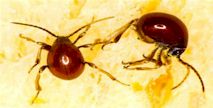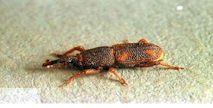
Small beetles, length 2-3mm
- Although distinguished by the four orange-reddish patches on its
body.

- The head bears a slender snout and the shield behind the head (pronotum) have course round punctures. The elytra have deep lines (striae) and course punctures. Larvae are legless, white and rotund with a distinct head capsule.
- Both weevils have chewing mouthparts at the end of their snouts or prolonged heads, and are about 1/8- to 3/16-inch long, depending on the size of the grain kernel. In small grains, such as millet or milo maize, weevils are small in size; they are larger in corn. The adult granary weevil is a shiny reddish-brown with elongated pits on the thorax, whereas the adult rice weevil is a dull reddish-brown with round or irregularly shaped pits on the thorax and four light spots on the wing covers. These deep round punctures and light spots are lacking on the granary weevil. Also, the granary weevil cannot fly, whereas the rice weevil can fly. Both weevils in the larval stage are legless, humpbacked, white to creamy white, with a small, tan head. Weevils in the pupa stage have snouts like the adults. The maize weevil is similar to the rice weevil, but larger.
- Elongate snout bears small mouthparts that are mostly hidden; tarsi are 5-segmented but appear 4-segmented. Larvae are whitish, generally c- shaped and legless.
-
Mouthparts are for chewing. Found in stored grains of all types including wheat, corn, oats, barley, sorghum, macaroni, and other grain products. They may also infest grain in the field.
- Larvae hollow out kernels of grain and usually attack whole kernels. Holes in the side of the grain are made by adults and by the emerging adults. They build up in numbers in stored grain.
- Originally from Indo-Malayan region
- Moved around the world by trade in rice
- Adults are good fliers and easily disperse. Adults chew into the
grain kernels from the outside and also to lay eggs.
 Females can lay 300
to 400 eggs typically one per cavity. Larvae develop through several
stages (instars) inside the grain kernels and also pupate inside the
kernel. They may complete a generation in a month in warm conditions.
Adults often live for 7 to 8 months and some records are over 2 years.
Females can lay 300
to 400 eggs typically one per cavity. Larvae develop through several
stages (instars) inside the grain kernels and also pupate inside the
kernel. They may complete a generation in a month in warm conditions.
Adults often live for 7 to 8 months and some records are over 2 years. - The egg, larva, and pupa stages of both weevils occur in the grain kernels and are rarely seen. Feeding is done within the grain kernel, and adults cut exit holes to emerge. Emergence holes of the granary weevil are larger than those of the rice weevil, and tend to be more ragged than smooth and round. Females drill a tiny hole in the grain kernel; deposit an egg in the cavity, then plug the hole with a gelatinous secretion. The egg hatches into a young larva which bores toward the centre of the kkernel, feeds, grows, and pupates there. New adults bore emergence holes from the inside, then leave to mate and begin a new generation.
- Female granary weevils lay from 36 to 254 eggs. At 80 to 86 degrees F, 75- to 90-percent relative humidity, eggs hatch in wheat with a moisture content of 13.5 to 19.6 percent in 3 days. Larvae mature in 18 days, and the pupa in 6 days. The life cycle is about 30 to 40 days during the summer, and 123 to 148 days during the winter, depending on temperature. Adults live 7 to 8 months. Female rice weevils lay between 300 to 400 eggs, with the life cycle requiring about 32 days for completion. Rice weevil adults live 3 to 6 months, infesting grain in the field, especially in the South. Two larvae can develop in one wheat kernel, but only one larva of the granary weevil can develop per wheat kernel. Both granary and rice weevils feign death by drawing up their legs close to the body, falling, and remaining silent when disturbed.
Rice weevil is a cosmopolitan pest in stored grain products; medically harmless.
- Likely to be found wherever rice is stored
- Other types of grain have similar pests
-
Control of these insects by seed treatments is reliant on either the adults, in the case of cypermethrin, or larvae, when
 triflumuron is
used, feeding on the treated grain and hence the insecticide. When
feeding on treated grain, insecticide is ingested and the insect is
killed. Eggs and larvae feeding exclusively within the seed are not
controlled by this method, as there is no intake of chemical. However,
when they emerge, insecticide is ingested from the surface of the seed
and control is achieved.
triflumuron is
used, feeding on the treated grain and hence the insecticide. When
feeding on treated grain, insecticide is ingested and the insect is
killed. Eggs and larvae feeding exclusively within the seed are not
controlled by this method, as there is no intake of chemical. However,
when they emerge, insecticide is ingested from the surface of the seed
and control is achieved. - Only the larval stages of the moths consume grain. Therefore, adult moths may be present in treated grain, which is protected from larval damage by the insecticide. Further, the life cycle of the insect is interrupted and multiplication does not occur, as all larvae are killed by the protectant.
- In order to be effective, grain protectants are developed and formulated to maintain their toxic properties for an extended period.
- By contrast, a major stored grain insect of field peas, the pea weevil (Bruchus pisorum) is not controlled by seed treatments. Pea weevils infest the seed before harvest and do not ingest the seed during storage. Thus, multiplication can occur, uninhibited.
- Stored grain insects may also be controlled by:
- Cooling stored grain through aeration
- Treating grain with an insecticide powder such as Dryacide® or liquid residual chemicals
- Treating infested grain with dichlorvos
- Fumigating grain with phosphine
- Controlled atmosphere such as carbon dioxide in a gas-tight silo
- Treating storage areas and equipment with residual chemicals
- The simplest and most effective measure is to locate the source of infestation and quickly get rid of it. Use a flashlight or other light source to examine all food storage areas and food products carefully. If practical and regulations allow, dispose of heavily infested foods in wrapped, heavy plastic bags or in sealed containers for garbage removal, or bury deep in the soil. If you detect an infestation early, disposal alone may solve the problem.
- Storage of grains for a month or more during the warm, summer months may lead to infestations. Purchase grains in small quantities for early use, and store in containers of insect-proof glass, heavy plastic, or metal with screw-type, airtight lids. For longer storage, refrigerate or deep freeze.
- At the time of purchase, carefully examine whole grains, such as wheat, oats, rye, buckwheat, barley, corn, rice, birdseed, nuts, table beans, etc. for weevil infestations. Especially check grains purchased from grain storage facilities, processing plants, and stores. Fortunately, all stages of these weevils can be killed easily by super heating or cooling. Heat in a shallow pan in the oven at 120 degrees F for 1 hour or at 130 degrees F for 30 minutes, place in a deep freeze at 0 degrees F for 4 days, or heat in the microwave for 5 minutes. However, seeds saved for planting may have the germination reduced by super heating, cooling, or microwave methods. Properly ventilate the storage area to discourage these moisture-loving stored product pests. Be sure to store only clean, dry grain with a moisture content of 12 percent or less to reduce weevil problems.
Insecticides
- The use of insecticides is discouraged around food
materials. Insecticides are supplementary to sanitation and proper
 storage. Household insecticides have no effect on insects within food
packages. For extra protection, some treat seeds or grains before
storage with dusts or sprays of synergized pyrethrins, labeled for this
use. (Follow label directions and safety precautions.) If the problem
becomes severe and widespread, contact a reputable, licensed pest
control operator who has the training, experience, equipment, and
insecticides to get the control job accomplished safely.
storage. Household insecticides have no effect on insects within food
packages. For extra protection, some treat seeds or grains before
storage with dusts or sprays of synergized pyrethrins, labeled for this
use. (Follow label directions and safety precautions.) If the problem
becomes severe and widespread, contact a reputable, licensed pest
control operator who has the training, experience, equipment, and
insecticides to get the control job accomplished safely.